

Tuesday July 20, 2004
Fly Chrysler Oreca Viper
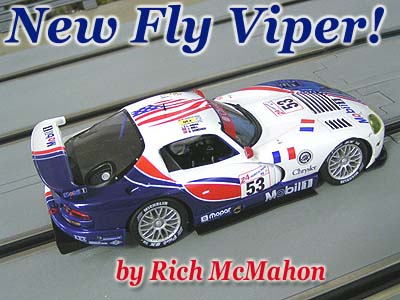 FLY
has introduced a fantastic new Viper. This is a very impressive slot car model,
it is one of the nicest cars I have seen and it runs very well on the
track. This car is not modeled after the new production Viper but it is a
replica of the Oreca team car that won its class at the 1998 Le Mans 24 hour
race. This is a great racecar to model as #53 was the first production American
car to have a class victory at this prestigious event.
FLY
has introduced a fantastic new Viper. This is a very impressive slot car model,
it is one of the nicest cars I have seen and it runs very well on the
track. This car is not modeled after the new production Viper but it is a
replica of the Oreca team car that won its class at the 1998 Le Mans 24 hour
race. This is a great racecar to model as #53 was the first production American
car to have a class victory at this prestigious event.
The Viper was the first model produced by FLY
Model Cars. Its introduction in 1996 was a sensation and it changed the
direction of the 1/32 scale slot car hobby. It revived the concept of slot cars
as scale models. These slot cars were replicas of actual racecars that had
raced only a few months before at the Daytona 24 hour race. The brilliant
graphics on the car included all of the correct race markings including the
driver’s names. The car also had had phenomenal on track performance due to a
very strong traction magnet. The original FLY Viper was the catalyst for all of
the great 1/32 scale items we have today, it was the motivation others needed to
improve their products. This slot car immediately established FLY as the
premier producer of scale model slot cars.
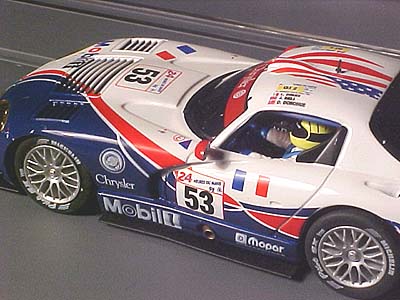
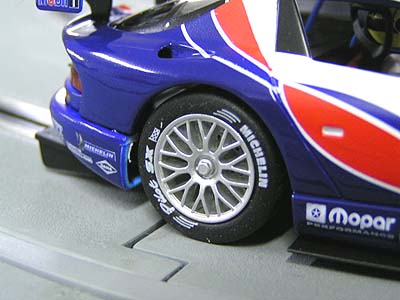
Over the years FLY has spewed out over forty different Viper paint schemes on
two different body styles, the latest version being the third generation Viper.
The first two generations are quite similar in appearance and the best way to
distinguish the two is by their hoods. The first generation has a small NASA
duct near the nose while the second generation has the vented hood. In the
photos the red #91 is the second generation and the white car is the first
generation. The second generation also had a stronger traction magnet and was
the first slot car I ever saw that was not quicker with silicone tires.
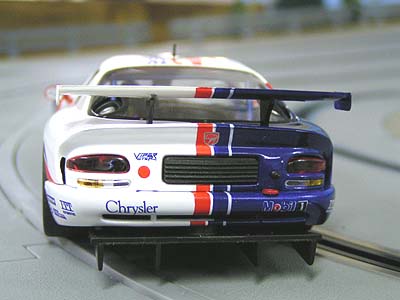
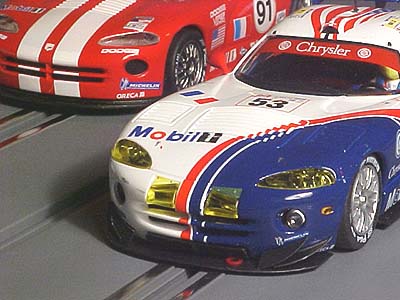
The Oreca Viper is all new sharing only the general shape and dimensions of the body; this shows how good the first of FLY's cars were scaled. FLY really is showing off their mastery of molding details on this model. It is just fantastic! For example you can see right through the hood vents because they are open, as are many of the scoops and slots found on this racecar. The rear wing is new but this is not too obvious unless the two are side by side. The paint work is wonderful. It is sharp, with a crisp and clear color separation. The intricate pattern of the ’98 Oreca team could not be captured better. The small printing such as sponsors and the drivers names are clear to see, but some may need a magnifying glass to read them.
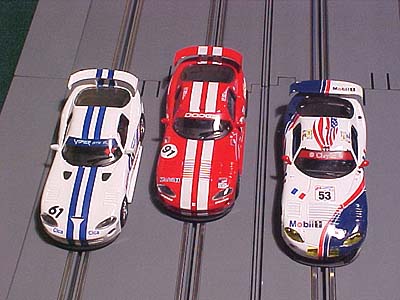
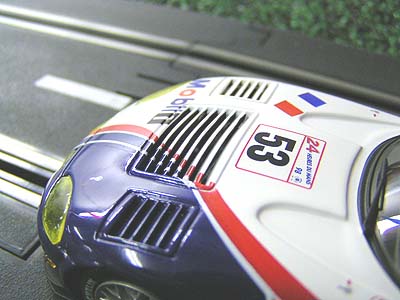
As good as the originals were in their day this latest Viper has even more small details modeled and the attention to these details is comprehensive. Every item looks as it does on an actual racecar. Tow hooks, antenna, latches, switches and items like the exhaust look real. The exhaust pipes stick out through the body under the doors and they look so good I expected them to be red-hot after a few good laps.
The Viper now has a full interior and driver, the original Viper being the only car in the FLY stable that did not have this feature. It is difficult to see all of the interior detail and even harder to take a good picture of it. The driver has separate belts and a decorated helmet; I wish they would indicate who this driver supposed to be. The decorated instrument panel is plainly visible as is the full roll cage.
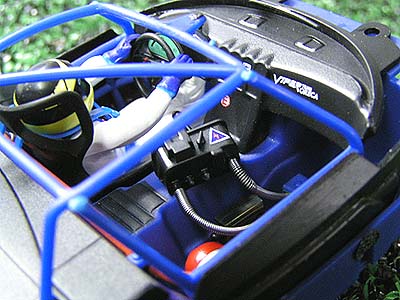
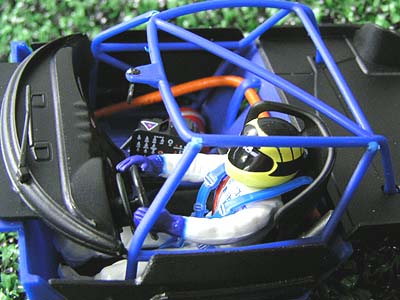
The chassis is all new. The
original Viper had a flat chassis that extended in front of the body; this was
to model the “splitter”, the aerodynamic feature that separates the air at the
front of the car. The advantage slot car wise is that this splitter absorbs and
distributes the impact energy of a front end crash to the chassis instead of
damaging the body. This brilliant feature is carried over to the latest Viper.
Unlike the original the rear chassis extends very far to simulate the rear
diffuser, another aero component that provides down force from under car
airflow.
A notable feature of the original that is not retained is the side exhaust pipes
being part of the chassis pan and protruding through both lower sides of the
body. This located and to a certain extent retained the body. This meant that
the body had to be spread apart for removing the body, confusing at first but
simple after you had figured it out the first time. The new body presents even
more of a challenge during removal and installation. At the nose of the car
the body will not lift straight up because part of the chassis that contains
some faux headlights and other small details gets a little hung up. Plus I
think the wheel openings in the body are wrapped too tight around the tires for
the body to lift directly off. I’m not exactly sure how I got it apart and back
together. I think I lifted the body just a bit then moved it to the right.
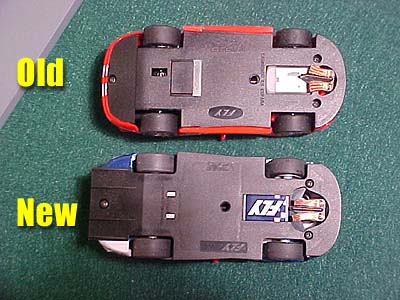
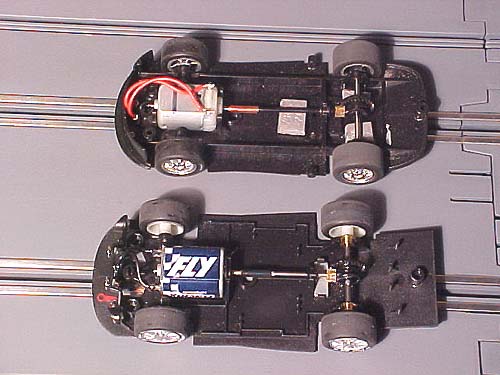
The chassis layout is similar to the original but not identical. The first
Vipers had an unconventional front motor with a long driveshaft but it worked
very well with the strong traction magnet. Like the original the motor is now
packaged in the front of the chassis but it is placed farther rearward, but not
back far enough for a straight front axle. The traction magnet is not the same
but is positioned in about the same spot. Stub axles hold the front wheels in
place as before. The rear now has bronze axle bushings.
The tires maybe the one item carried over from the previous model as they look identical, but the wheels are not the same. On the example I had they seem true and concentric, which was not always the case for the previous cars. These cars have always come with a shallow guide for toy like track. I don’t understand why FLY continues to make cars with these marginal guides, this is the one item I would like to see every slot car producer improve.
I was so eager to get this on the track I removed it from the traditional FLY display case, placed it on the track and… nothing. Upon inspecting the car the problem was obvious- the braid looked like it was ironed flat against the guide flag. Simply adjusting the braid properly and this car… well … flew! It has fantastic on track performance! It has good acceleration and top speed. This is a HOT motor. It also has a very strong magnetic traction, but that doesn’t take the driver out of the equation. When pushed too hard the tail would step out a bit but not de-slot, allowing one to continue racing. If too much throttle was applied too early on exiting a curve the shallow guide would come out of the slot and the car would flat spin. With such a strong traction magnet when it did come out of the slot it was traveling at a very high velocity. In all it is a very rewarding car to race. I originally thought this car was too fast for the tracks that I run on and I was considering installing a normal motor so my old Vipers could run with it, but now I am not sure I want to change it. This car is quick but it is also smooth and easy to drive.
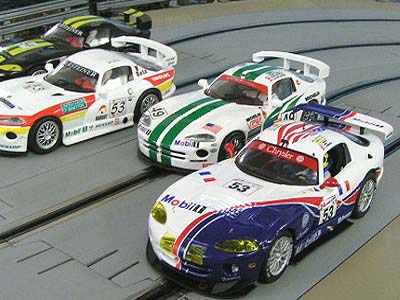 FLY
has shown this car in their catalog for quite a few years and I could not
understand why it was taking so long to hit the store. It is now pretty obvious
they wanted to have something very special as the model of this great Le Mans
racecar. This excellent scale model racecar is now available with and without
headlight beams. A Team set is also available with these cars. I am looking
forward to more variations of this car and I hope one is modeled after the
overall winner of the 2000 Daytona 24-hour race.
FLY
has shown this car in their catalog for quite a few years and I could not
understand why it was taking so long to hit the store. It is now pretty obvious
they wanted to have something very special as the model of this great Le Mans
racecar. This excellent scale model racecar is now available with and without
headlight beams. A Team set is also available with these cars. I am looking
forward to more variations of this car and I hope one is modeled after the
overall winner of the 2000 Daytona 24-hour race.
- Rich
Rich is a long time slot car
enthusiast and contributing editor for several magazines.
You can find him online here
in our
Message Forums
to comment on this article or just the hobby in general.
Thanks go to Scalextric-USA for providing us with this model.
